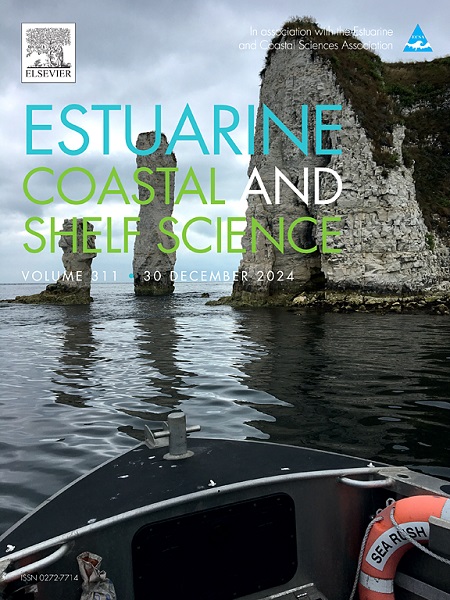Effects of regional oceanography and climate variability on larval connectivity of the wedge clam Donax hanleyanus in South American beaches
IF 2.6
3区 地球科学
Q1 MARINE & FRESHWATER BIOLOGY
引用次数: 0
Abstract
The wedge clam, Donax hanleyanus, inhabits sandy beaches in the subtropical and temperate regions of the Atlantic coast of South America. Its distribution spans over 20 degrees of latitude from Brazil to Argentina, with the southernmost part of its range being influenced by the Rio de la Plata (RdlP) estuary, which limits the southward larval expansion. We used an individual-based model (IBM) to assess the larval connectivity patterns of the wedge clam during the period 2000–2012. The IBM combines a 3D hydrodynamic model with a biological sub-model that considers larval mortality due to low salinity (<7, and <9) and sea surface temperature range (high >30 °C or low <9 °C). The main larval connectivity patterns were observed near the release/recruitment areas, suggesting a high potential for self-recruitment. Based on the IBM and adult abundance data, we also identified the likely source and sink areas within this metapopulation. Source beach areas were Navegantes and Cassino in Brazil (from 26.3° S to 34.34°S), Arachania in Uruguay (34.56°S), and Santa Teresita in Argentina (37.15°S). A low probability of larval transport towards the poleward limit of the species' distribution was observed, supporting an irregular recruitment pattern typical of sink populations located at the edge of the distribution range of metapopulations. Larval mortality due to warm or cold waters did not affect connectivity patterns for this subtropical species. Southward larval transport across the RdlP estuary (from Uruguayan to Argentine beaches) only occurred for larvae released on early January 2011, concurrently with the strongest La Niña year observed during the study period. In light of a changing climate, marked by potential increases in extreme La Niña events and a poleward shift of atmospheric circulation patterns over the South Atlantic, we anticipate a strengthening of larval transport across the RdlP and a subsequent poleward expansion of the species’ distribution range.
区域海洋学和气候变率对南美海滩楔蛤幼虫连通性的影响
楔蛤(Donax hanleyanus)生活在南美洲大西洋沿岸亚热带和温带地区的沙滩上。它的分布横跨从巴西到阿根廷的20多度纬度,其范围的最南端受到里约热内卢de la Plata (RdlP)河口的影响,这限制了幼虫向南扩张。我们使用基于个体的模型(IBM)来评估2000-2012年期间楔形蛤的幼虫连接模式。IBM将3D流体动力学模型与生物子模型相结合,考虑了低盐度(<;7和<;9)和海面温度范围(高>;30°C或低<;9°C)造成的幼虫死亡率。主要的幼虫连通性模式在释放/招募区附近观察到,表明自我招募的潜力很大。基于IBM和成人丰度数据,我们还确定了这个元种群中可能的来源和汇区。源滩区为巴西的Navegantes和Cassino(26.3°S ~ 34.34°S)、乌拉圭的Arachania(34.56°S)和阿根廷的Santa Teresita(37.15°S)。观察到幼虫向物种分布的极地极限迁移的可能性很低,这支持了位于超种群分布范围边缘的典型汇种群的不规则招募模式。温水或冷水对该亚热带物种的连通性模式没有影响。在2011年1月初释放的幼虫仅发生了通过RdlP河口(从乌拉圭海滩到阿根廷海滩)向南迁移的现象,同时也是研究期间观察到的最强La Niña年。鉴于气候变化,极端La Niña事件的潜在增加和南大西洋大气环流模式的极移,我们预计幼虫在rdp的运输将加强,随后物种分布范围将向极地扩展。
本文章由计算机程序翻译,如有差异,请以英文原文为准。
求助全文
约1分钟内获得全文
求助全文
来源期刊
CiteScore
5.60
自引率
7.10%
发文量
374
审稿时长
9 months
期刊介绍:
Estuarine, Coastal and Shelf Science is an international multidisciplinary journal devoted to the analysis of saline water phenomena ranging from the outer edge of the continental shelf to the upper limits of the tidal zone. The journal provides a unique forum, unifying the multidisciplinary approaches to the study of the oceanography of estuaries, coastal zones, and continental shelf seas. It features original research papers, review papers and short communications treating such disciplines as zoology, botany, geology, sedimentology, physical oceanography.

 求助内容:
求助内容: 应助结果提醒方式:
应助结果提醒方式:


